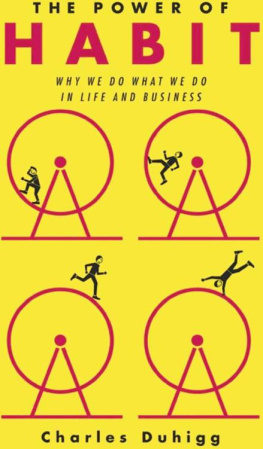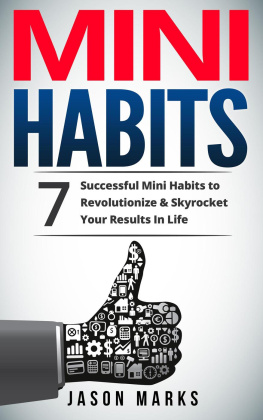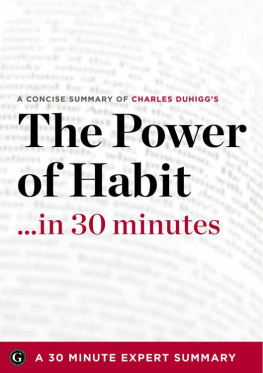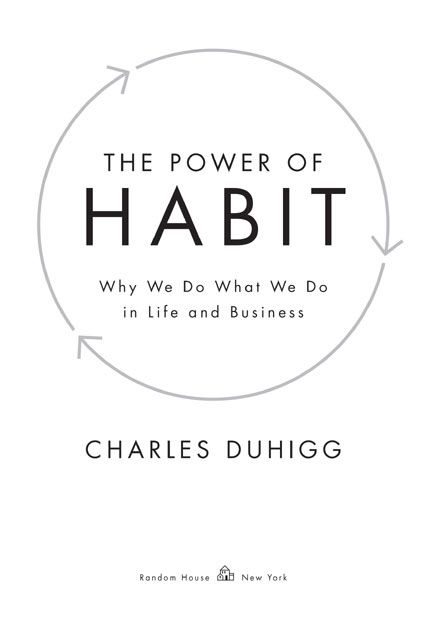Duhigg - The power of habit : why we do what we do in life and business
Here you can read online Duhigg - The power of habit : why we do what we do in life and business full text of the book (entire story) in english for free. Download pdf and epub, get meaning, cover and reviews about this ebook. City: New York, year: 2012, publisher: Random House Digital, Inc., genre: Detective and thriller. Description of the work, (preface) as well as reviews are available. Best literature library LitArk.com created for fans of good reading and offers a wide selection of genres:
Romance novel
Science fiction
Adventure
Detective
Science
History
Home and family
Prose
Art
Politics
Computer
Non-fiction
Religion
Business
Children
Humor
Choose a favorite category and find really read worthwhile books. Enjoy immersion in the world of imagination, feel the emotions of the characters or learn something new for yourself, make an fascinating discovery.
- Book:The power of habit : why we do what we do in life and business
- Author:
- Publisher:Random House Digital, Inc.
- Genre:
- Year:2012
- City:New York
- Rating:3 / 5
- Favourites:Add to favourites
- Your mark:
The power of habit : why we do what we do in life and business: summary, description and annotation
We offer to read an annotation, description, summary or preface (depends on what the author of the book "The power of habit : why we do what we do in life and business" wrote himself). If you haven't found the necessary information about the book — write in the comments, we will try to find it.
In this book the author, a New York Times business reporter, takes us to the edge of scientific discoveries that explain why habits exist and how they can be changed. With an ability to distill vast amounts of information into engrossing narratives, he brings to life a whole new understanding of human nature and its potential for transformation. Along the way we learn why some people and companies struggle to change, despite years of trying, while others seem to remake themselves overnight. We visit laboratories where neuroscientists explore how habits work and where, exactly, they reside in our brains. We discover how the right habits were crucial to the success of Olympic swimmer Michael Phelps, Starbucks CEO Howard Schultz, and civil-rights hero Martin Luther King, Jr. We go inside Proctor & Gamble, Target superstores, Rick Warrens Saddleback Church, NFL locker rooms, and the nations largest hospitals to see how implementing so-called keystone habits can earn billions and mean the difference between failure and success, life and death. Habits are not destiny; the author maintains that by harnessing this new science, we can transform our business, our communities, and our lives. Read more...
Abstract: In this book the author takes us to the thrilling edge of scientific discoveries that explain why habits exist and how they can be changed.
In this book the author, a New York Times business reporter, takes us to the edge of scientific discoveries that explain why habits exist and how they can be changed. With an ability to distill vast amounts of information into engrossing narratives, he brings to life a whole new understanding of human nature and its potential for transformation. Along the way we learn why some people and companies struggle to change, despite years of trying, while others seem to remake themselves overnight. We visit laboratories where neuroscientists explore how habits work and where, exactly, they reside in our brains. We discover how the right habits were crucial to the success of Olympic swimmer Michael Phelps, Starbucks CEO Howard Schultz, and civil-rights hero Martin Luther King, Jr. We go inside Proctor & Gamble, Target superstores, Rick Warrens Saddleback Church, NFL locker rooms, and the nations largest hospitals to see how implementing so-called keystone habits can earn billions and mean the difference between failure and success, life and death. Habits are not destiny; the author maintains that by harnessing this new science, we can transform our business, our communities, and our lives
Duhigg: author's other books
Who wrote The power of habit : why we do what we do in life and business? Find out the surname, the name of the author of the book and a list of all author's works by series.









